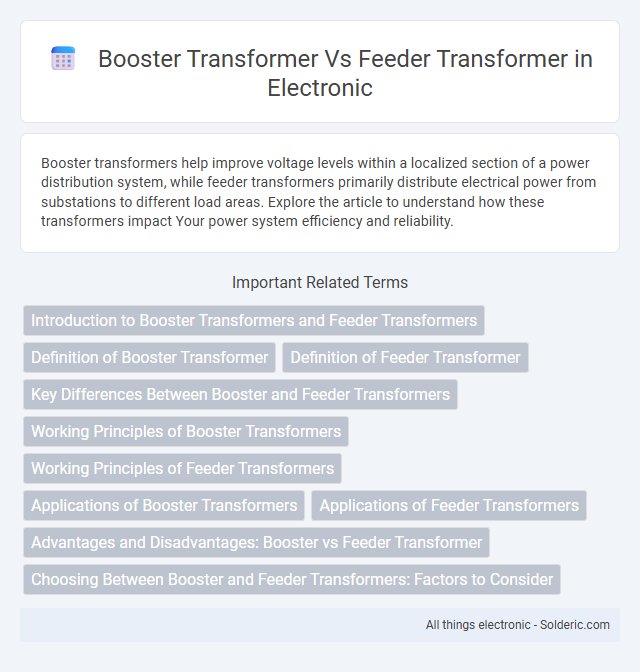Booster transformers help improve voltage levels within a localized section of a power distribution system, while feeder transformers primarily distribute electrical power from substations to different load areas. Explore the article to understand how these transformers impact Your power system efficiency and reliability.
Comparison Table
| Feature | Booster Transformer | Feeder Transformer |
|---|---|---|
| Primary Function | Voltage regulation and correction in power lines | Power distribution from substation to consumers |
| Connection | Connected in series with the distribution feeder | Connected in parallel to distribution network |
| Voltage Adjustment | Provides voltage boost or reduction (fine tuning) | Steps down high voltage to usable lower voltage levels |
| Capacity | Lower KVA rating, designed for voltage support | Higher KVA rating for bulk power supply |
| Typical Use | Corrects voltage drop on long feeders | Supplies power to residential, commercial, or industrial loads |
| Installation Location | Along the distribution feeder line | At substations or distribution points |
Introduction to Booster Transformers and Feeder Transformers
Booster transformers regulate voltage by providing a controlled voltage boost or buck in distribution systems, improving power quality and stability. Feeder transformers, on the other hand, step down high voltage from the substation to a lower voltage suitable for distribution to consumers, ensuring efficient energy delivery. Your choice between these transformers depends on the specific voltage regulation and distribution requirements of your electrical network.
Definition of Booster Transformer
A booster transformer is a specialized transformer used to adjust voltage levels within an existing electrical system, typically by increasing or decreasing voltage in small increments to maintain system stability. Unlike feeder transformers, which distribute power directly to loads, booster transformers are connected in series with a line to correct voltage drops or regulate voltage levels without interrupting the power flow. Your electrical network benefits from booster transformers by enhancing voltage control and improving overall system performance.
Definition of Feeder Transformer
A feeder transformer is a type of electrical transformer that supplies power from the main distribution network to various localized circuits, ensuring voltage regulation and load balancing. Unlike a booster transformer, which is designed to adjust or boost voltage levels in specific parts of a power system, the feeder transformer primarily handles the direct distribution of electrical energy to end-use equipment or smaller substations. Your electrical system relies on feeder transformers to maintain efficient and stable power delivery across connected loads.
Key Differences Between Booster and Feeder Transformers
Booster transformers are specialized transformers designed to regulate voltage by adding or subtracting a small voltage boost in an existing power line, typically used in distribution systems to correct voltage drops. Feeder transformers, on the other hand, directly transform high voltage from the substation to a lower voltage suitable for distribution to end-users, serving as a critical link between transmission and distribution networks. The main difference lies in their function: booster transformers adjust voltage levels within the distribution network, whereas feeder transformers provide the initial voltage step-down necessary for distribution feeders.
Working Principles of Booster Transformers
Booster transformers operate by injecting a voltage that either adds to or subtracts from the feeder voltage, effectively regulating and stabilizing the voltage level along the distribution line. They work on the principle of voltage compensation, using a series-connected transformer that adjusts the output voltage to counteract voltage drops caused by load variations. This precise voltage control ensures improved power quality and reliability in electrical distribution systems compared to standard feeder transformers.
Working Principles of Feeder Transformers
Feeder transformers operate by stepping down voltage from higher levels to usable lower levels directly along distribution feeders, ensuring stable power delivery to end-users. They are connected in series with the feeder, effectively maintaining voltage levels and reducing losses across long-distance power lines. Their working principle revolves around voltage regulation and load distribution to enhance the efficiency and reliability of electrical distribution networks.
Applications of Booster Transformers
Booster transformers are primarily used to correct voltage drops in electrical distribution networks, enhancing voltage levels for sensitive equipment and improving overall power quality. Their applications include electric railway systems for maintaining consistent voltage, and industrial plants where precise voltage control is critical to ensure operational efficiency and prevent equipment damage. Unlike feeder transformers that supply power to distribution lines, booster transformers specifically augment voltage to counteract losses over long distances or heavy load conditions.
Applications of Feeder Transformers
Feeder transformers are primarily used in electrical distribution systems to step down voltage levels for safe and efficient power delivery to residential, commercial, and industrial loads. They are critical in extending electrical networks by supplying power to secondary distribution circuits and ensuring voltage stability across feeders. Their applications also include integration with renewable energy sources and maintaining load balancing in complex power grids.
Advantages and Disadvantages: Booster vs Feeder Transformer
Booster transformers enhance voltage levels locally, improving power quality in specific areas while minimizing transmission losses; however, they add complexity and maintenance demands. Feeder transformers distribute power over wider areas efficiently, supporting large loads with stable voltage but may experience higher line losses and less voltage control flexibility. You should consider the specific load demands and system configuration when choosing between booster and feeder transformers for optimal efficiency and reliability.
Choosing Between Booster and Feeder Transformers: Factors to Consider
Selecting between booster and feeder transformers depends on load regulation, voltage control, and installation complexity. Booster transformers are ideal for fine voltage adjustments in localized circuits without extensive infrastructure changes, while feeder transformers efficiently supply power over longer distances with stable voltage levels. Your choice should align with specific load demands, voltage stability requirements, and overall system design considerations.
booster transformer vs feeder transformer Infographic

 solderic.com
solderic.com